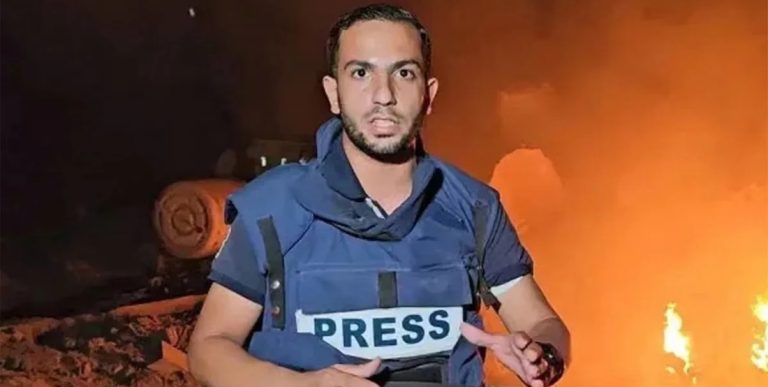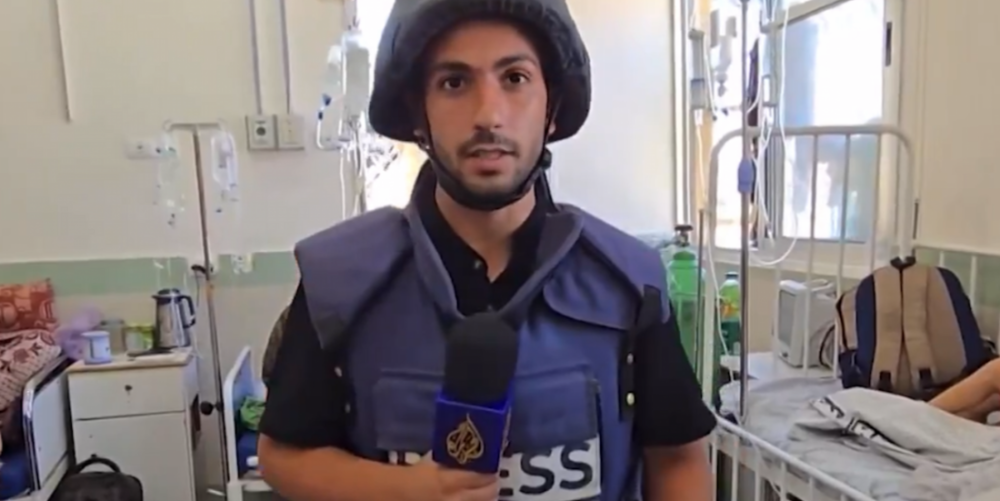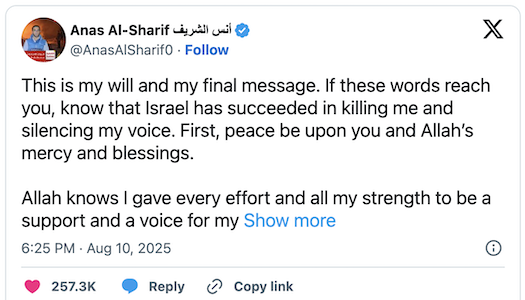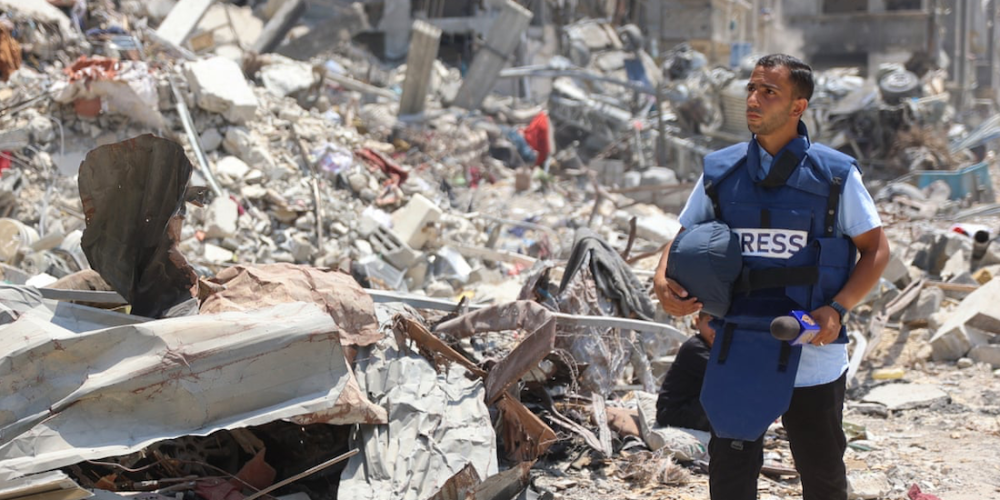
Israel Claims Targeted Reporter Was “Hamas Commander;” Al Jazeera Calls It Assassination as Funeral Draws Mourners Amid Ruins

New York, N.Y. — The shattered courtyard of Al-Shifa Hospital in Gaza City filled with grief and anger today as dozens of Palestinians gathered to bury six journalists killed in an Israeli airstrike.
The attack, which targeted a tent clearly marked for media personnel outside the hospital’s main gate, claimed the lives of five Al Jazeera staff members and a freelance reporter on Sunday.
Israel confirmed it deliberately targeted prominent correspondent
Anas al-Sharif, 28, accusing him of being a Hamas commander—
a claim met with widespread skepticism as no evidence was presented.
Mourners navigated the debris of bombed-out buildings, carrying the bodies of the journalists, each wrapped in white shrouds with faces exposed, through narrow alleys towards their final resting place. Men wearing distinctive blue journalists’ flak jackets were among those bearing the coffins, a stark visual testament to the deadly risks faced by reporters covering the now 22-month-old war.

Targeted Strike Amidst Growing Isolation
The strike occurred outside the gates of Al-Shifa Hospital, a facility repeatedly besieged during the conflict. Al Jazeera stated its employees were working from a tent explicitly established for journalists. Dr. Mohammed Abu Salmiya, the hospital’s director, confirmed the sixth victim as freelance reporter Mohammed Al-Khaldi. In total, seven people died in the attack.
Israel’s military issued a statement asserting it had targeted al-Sharif, labeling him a “terrorist” affiliated with Hamas who “posed as a journalist.” It claimed he “served as the head of a terrorist cell” and was involved in rocket attacks against Israeli civilians and troops. The military published a graphic listing what it said were Hamas operatives in northern Gaza, featuring al-Sharif’s name marked “Eliminated,” and promised documents proving his affiliation.
However, press freedom advocates immediately noted the absence of any publicly verifiable evidence, a pattern following previous killings of journalists in Gaza by Israeli forces.
Al Jazeera Condemns “Blatant” Attack on Press Freedom
Al Jazeera vehemently condemned the killings as a “targeted assassination” and “yet another blatant and premeditated attack on press freedom.”
The network stated al-Sharif and his slain colleagues—correspondent Mohammed Qreiqeh and cameramen Ibrahim Zaher, Mohammed Noufal, and Moamen Aliwa—were “among the last remaining voices documenting the realities of life in Gaza.”

The broadcaster accused Israel of killing ten of its journalists since October 2023, along with numerous family members.
Al-Sharif was one of the most recognizable faces reporting daily from Gaza throughout the conflict.
Shortly before his death, he posted on X about intense Israeli bombardment, warning of “fire belts” in parts of Gaza City.
In a poignant, pre-written message published posthumously, he stated: “If these words of mine reach you, know that Israel has succeeded in killing me and silencing my voice. Do not forget Gaza, and do not forget me in your sincere prayers for forgiveness and acceptance.”
He wrote of his commitment to convey the truth “without distortion” and lamented the international community’s failure to be moved by the “mangled bodies of our children and women.”
‘A desperate attempt to silence voices’
International Outcry Over Silencing of Gaza’s Witnesses
The killings prompted swift and sharp condemnation internationally and from media advocacy groups. Ireland‘s Tánaiste, Simon Harris, declared Israel’s killing of journalists in Gaza amounted to the “silencing of some of the few journalistic voices left” in the region. SIPTU, Ireland’s largest union, labeled the attack an atrocity and an assault on all media workers.
The National Union of Journalists (NUJ) in Ireland held a protest vigil at the Spire in Dublin to condemn the killings.
The Committee to Protect Journalists (CPJ), which had warned last month that al-Sharif was in “acute” danger, strongly condemned the strike. “Israel’s pattern of labelling journalists as militants without providing credible evidence raises serious questions about its intent and respect for press freedom,” stated Sara Qudah, CPJ’s Middle East and North Africa director.
U.N. special rapporteur on freedom of expression, Irene Khan, echoed these concerns, having previously warned that journalists in Gaza were being killed based on “unsubstantiated claims” linking them to Hamas.

A Deadly Pattern and Grim Statistics
This incident follows a disturbing pattern. In April, Israeli forces bombed a media camp near Nasser Hospital in Khan Younis, killing journalist Hassan Aslih, whom Israel subsequently described as a “terrorist from the Hamas Khan Yunis brigade,” again without presenting evidence.
Ahmed Mansur and Hilmi al-Faqaawi also died in that attack. Rights groups assert that Israel has killed more than 200 journalists and media workers in Gaza since the war began in October 2023, making it the deadliest conflict for journalists since records began. The CPJ states that nearly 70% of all journalists killed globally in 2024 died in Gaza, predominantly at the hands of the Israeli military.
Al Jazeera correspondent Hani Mahmoud, who was one block away during Sunday’s strike, described reporting on his colleague al-Sharif’s death as “the hardest thing I have had to do in the past 22 months of war.” He asserted the journalists were killed specifically “because of their relentless reporting on the starvation and malnutrition” devastating the Gaza Strip population.
The strike occurred mere hours after Israeli Prime Minister Benjamin Netanyahu [Luce Index™ score: 51/100] announced a policy shift, pledging to allow some foreign media into Gaza for the first time since the war’s outset—a move met with cynicism by many observers in light of the ongoing targeting of local journalists who have been the world’s primary window into the enclave’s suffering.
As the white-shrouded bodies were lowered into the ground amidst the ruins of Gaza City, the question hanging over the funeral was not just who would bear witness next, but whether any voice reporting the harsh realities of life and death under bombardment could truly be safe.
Tragedy: Gaza Buries Journalists Israel Killed in Strike on Media Tent (Aug. 12, 2025)
Summary
In a Gaza City hospital courtyard scarred by war, mourners buried six journalists killed by an Israeli airstrike on a marked media tent. Israel claimed it targeted prominent Al Jazeera reporter Anas al-Sharif as a Hamas commander but provided no evidence. Al Jazeera condemned the attack as an assassination silencing vital voices. The strike drew international condemnation, highlighting the extreme danger for journalists in Gaza, where over 200 media workers have been killed since October 2023, making it the deadliest conflict for reporters on record.